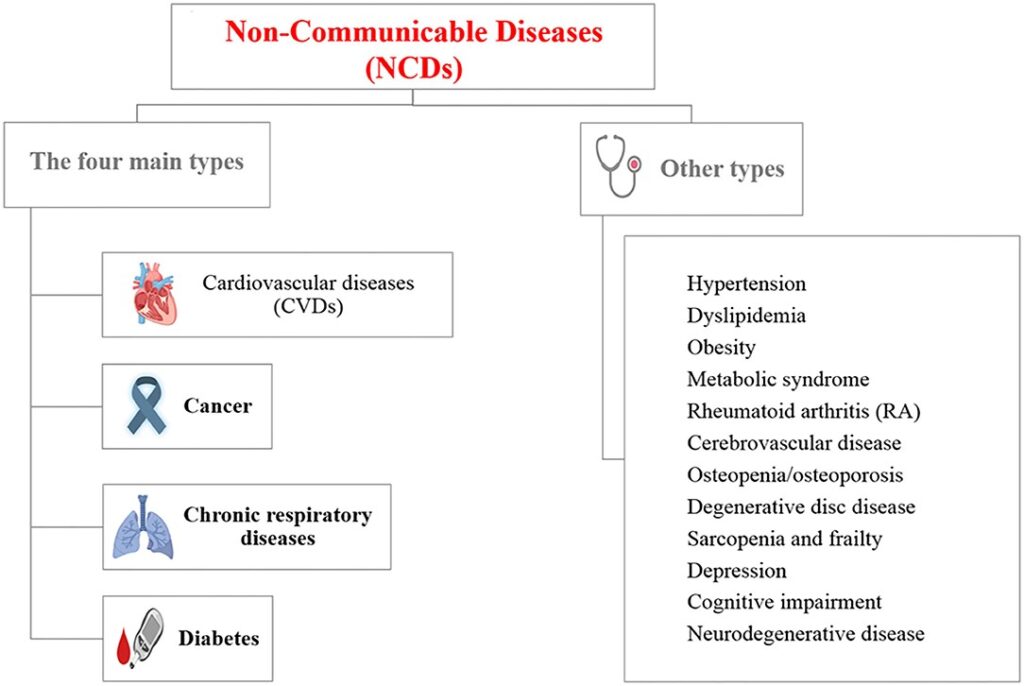Non Communicable Diseases and Control
Technical Areas
What are they?
The term NCDs refers to a group of diseases that are noninfectious, result in long-term health effects and often require long-term treatment, care and support. Examples of NCDs include chronic respiratory disease, cancers, diabetes and heart disease[1]. Other conditions such as injuries and mental health disorders are also categorized as NCDs. The four common risk factors for NCDs include; tobacco use, alcohol consumption, physical inactivity and unhealthy food consumption. Deaths from NCDs are noted to exceed all communicable disease deaths combined and early detection, screening and treatment as well as palliative care, are critical for their effective management. The epidemic of NCDs is now widely acknowledged as a serious global development challenge in the 21st century and a notable threat to the realization of the Sustainable Development Goals. NCDs are enshrined in international declarations such as the 2002 Johannesburg Declaration on Sustainable Development, the concurrent Johannesburg Plan of Implementation, the 2009 Economic and Social Council (ECOSOC) Ministerial Declaration and the Political Declaration on the Prevention and Control of Non-Communicable Diseases[2].
Technical Areas
Figure showing the list of Non-communicable diseases

Adopted from Aida Budreviciute et al., (2020)
Technical Areas
Global challenges and opportunities
According to the Center for Disease Control and Prevention, NCDs account for the death of 41 million people each year which equates to over 70% of global deaths. It is reported that social economic and structural factors including unhealthy lifestyles have exacerbated the NCD crisis that is responsible for the premature annual deaths of 15 million people before the age of 70. The high burden of NCDs is responsible for increasing the cost of health care, promotion of unproductivity and financial insecurity[1]. Organization of NCD services at the PHC level is limited by a myriad of factors such as non-adherence to standard treatment guidelines and protocols, under-regulation of informal and for-profit practitioners, poor health information system and record-keeping, and poor health care provider coordination. This is in addition to inadequate functional referral services, medicine, diagnostic facilities, and logistics supplies. Another challenge relates to the work force which is inadequately skilled to effectively diagnose and treat NCD cases. The availability of NCD-related policy frameworks, the large network of healthcare infrastructure, and the high demand for NCD services are some of the major opportunities[2].
Technical Areas
Key facts about NCDs
- NCDs account for 41 million annual deaths globally which equates to over 70% of all deaths globally.
- Over 85% of premature deaths take place in the low and middle income countries (LMICs)
- Cardiovascular disease is responsible for most NCD deaths, or 17.9 million deaths annually. This is followed by cancers (9.0 million), respiratory diseases (3.9 million), and diabetes (1.6 million).
- Cardiovascular diseases, cancers, respiratory diseases and diabetes account for over 80% of all premature NCD deaths.
- LMICs are estimated to suffer from economic losses that surpass $500 billion per year as a result of NCDs.
Center for Disease Control and Prevention
Every two seconds, a person dies prematurely from an NCD
Technical Areas
Recommendations
- Strengthen participatory health governance and community engagement to improve accountability and quality in NCD programme management.
- Integrate NCDs in primary health care to accelerate progress towards universal health coverage and empower communities in NCD prevention.
- Enact or strengthen NCD policies to provide an enabling environment for prevention and case management and a reduction in the associated risks factors.
- Innovate rapid and sensitive diagnostic platforms to detect NCDs at the points of care
- Strengthen multi-sectoral coordination between health and non-health sectors for concerted efforts against NCDs.
- Appropriate more resources to support PHC and NCD prevention and case management.
- Strengthening best practice sharing to ensure lessons are learned for improvement in the NCD landscape
- Conduct research including baseline, midterm and end line evaluation of NCD programmes.
- Development of NCD toolkits, policies, advocacy and communication materials
- Capacity building of the health care work force in NCD prevention and case management
Technical Areas
What Bodmando does in the technical area of Non-Communicable Diseases
Technical Areas
References
- Budreviciute, Aida, Samar Damiati, Dana Khdr Sabir, Kamil Onder, Peter Schuller-Goetzburg, Gediminas Plakys, Agne Katileviciute, Samir Khoja, and Rimantas Kodzius. “Management and Prevention Strategies for Non-Communicable Diseases (NCDs) and Their Risk Factors.” Frontiers in Public Health 8 (November 26, 2020): 574111. https://doi.org/10.3389/fpubh.2020.574111.
- Centers for Disease Control and Prevention. “About Global NCDs | Division of Global Health Protection | Global Health | CDC,” January 5, 2022. https://www.cdc.gov/globalhealth/healthprotection/ncd/global-ncd-overview.html.
- Kabir, Ashraful, Md Nazmul Karim, and Baki Billah. “Health System Challenges and Opportunities in Organizing Non-Communicable Diseases Services Delivery at Primary Healthcare Level in Bangladesh: A Qualitative Study.” Frontiers in Public Health 10 (November 9, 2022): 1015245. https://doi.org/10.3389/fpubh.2022.1015245.
- Luciani, Silvana, Irene Agurto, Reynaldo Holder, Roberta Caixeta, and Anselm Jm Hennis. “Integrated Approach for Noncommunicable Disease Management in the Americas.” Revista Panamericana de Salud Pública 46 (September 2, 2022): 1. https://doi.org/10.26633/RPSP.2022.154.
- Nath, Anita, MartinaA.J. Shalini, and Prashant Mathur. “Health Systems Challenges and Opportunities in Tackling Non-Communicable Diseases in Rural Areas of India.” The National Medical Journal of India 34, no. 1 (2021): 29. https://doi.org/10.4103/0970-258X.323661.
- PAHO/WHO. “Noncommunicable Diseases.” Accessed February 5, 2024. https://www.paho.org/en/topics/noncommunicable-diseases.
- Pan, Zhangyang, Jing Wu, and Yunguo Liu. “Strengthening the Primary Health Care for Non-Communicable Disease Prevention and Control in the Post-Pandemic Period: A Perspective from China.” Global Health Research and Policy 8, no. 1 (November 29, 2023): 49. https://doi.org/10.1186/s41256-023-00336-9.
- The NCD Alliance. “Tackling Non Communicable Diseases to Enhance Sustainable Development,” n.d.

